Page 227 of 308
Maintenance
2
7
ENGINE COMPARTMENT
OHD076002R
1. Engine coolant reservoir
2. Engine oil filler cap
3. Brake fluid reservoir
4. Air cleaner
5. Fuse box
6. Negative battery terminal
7. Positive battery terminal
8. Auto transaxle oil dipstick*
9. Radiator cap
10. Engine oil dipstick
11. Windshield washer fluid reservoir
12. Clutch fluid reservoir*
* : if equipped
■■
Petrol Engine (2.0L)
Page 230 of 308
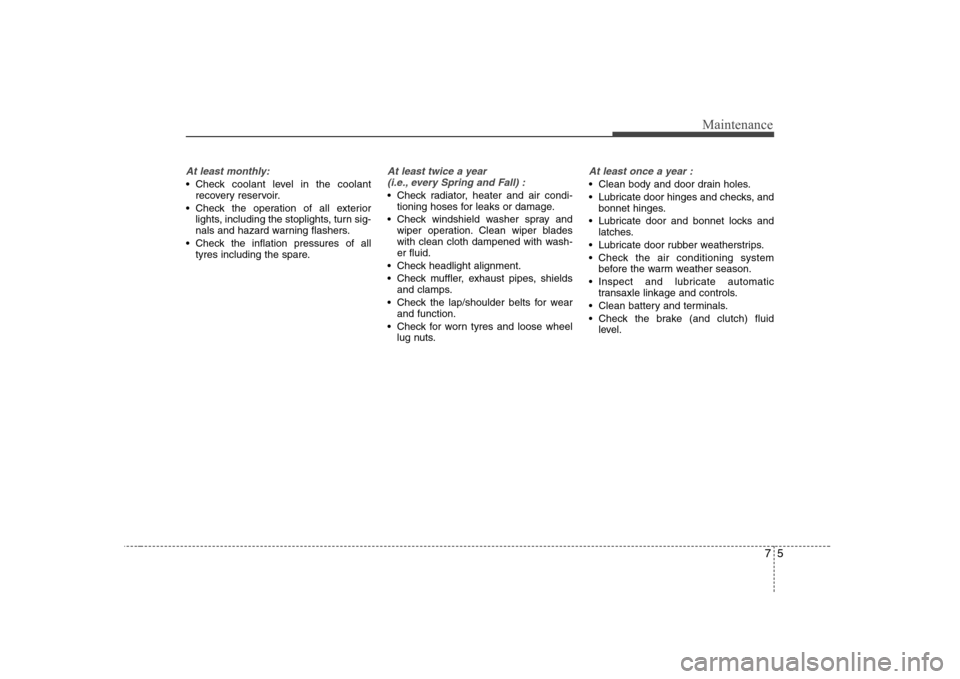
75
Maintenance
At least monthly:
Check coolant level in the coolantrecovery reservoir.
Check the operation of all exterior lights, including the stoplights, turn sig-
nals and hazard warning flashers.
Check the inflation pressures of all tyres including the spare.
At least twice a year
(i.e., every Spring and Fall) :
Check radiator, heater and air condi- tioning hoses for leaks or damage.
Check windshield washer spray and wiper operation. Clean wiper blades
with clean cloth dampened with wash-er fluid.
Check headlight alignment.
Check muffler, exhaust pipes, shields and clamps.
Check the lap/shoulder belts for wear and function.
Check for worn tyres and loose wheel lug nuts.
At least once a year :
Clean body and door drain holes.
Lubricate door hinges and checks, and
bonnet hinges.
Lubricate door and bonnet locks and latches.
Lubricate door rubber weatherstrips.
Check the air conditioning system before the warm weather season.
Inspect and lubricate automatic transaxle linkage and controls.
Clean battery and terminals.
Check the brake (and clutch) fluid level.
Page 234 of 308
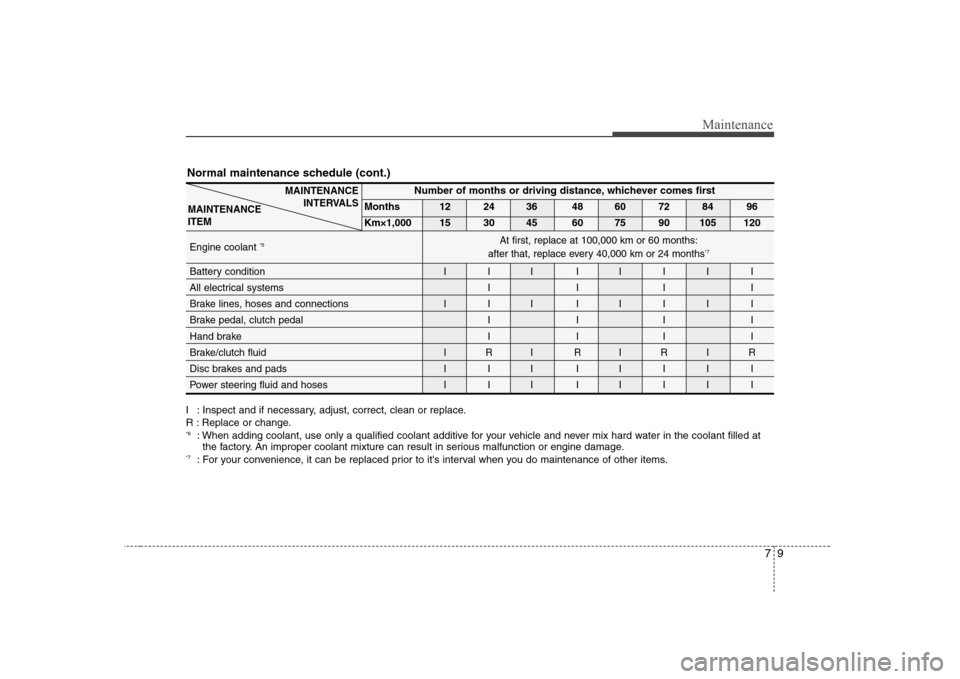
79
Maintenance
Normal maintenance schedule (cont.)
I : Inspect and if necessary, adjust, correct, clean or replace.
R : Replace or change. *6: When adding coolant, use only a qualified coolant additive for your vehicle and never mix hard water in the coolant filled at
the factory. An improper coolant mixture can result in serious malfunction or engine damage.
*7 : For your convenience, it can be replaced prior to it's interval when you do maintenance of other items.
MAINTENANCE
INTERVALS
MAINTENANCE ITEMNumber of months or driving distance, whichever comes first
Months 12 24 36 48 60 72 84 96
Km×1,000 15 30 45 60 75 90 105 120
Engine coolant *6
Battery condition I I I I I I I I
All electrical systems I I I I
Brake lines, hoses and connections I I I I I I I I
Brake pedal, clutch pedal I I I I
Hand brake I I I I
Brake/clutch fluid
IRI RIRIR
Disc brakes and pads I I I I I I I I
Power steering fluid and hoses I I I I I I I I
At first, replace at 100,000 km or 60 months:
after that, replace every 40,000 km or 24 months*7
Page 244 of 308
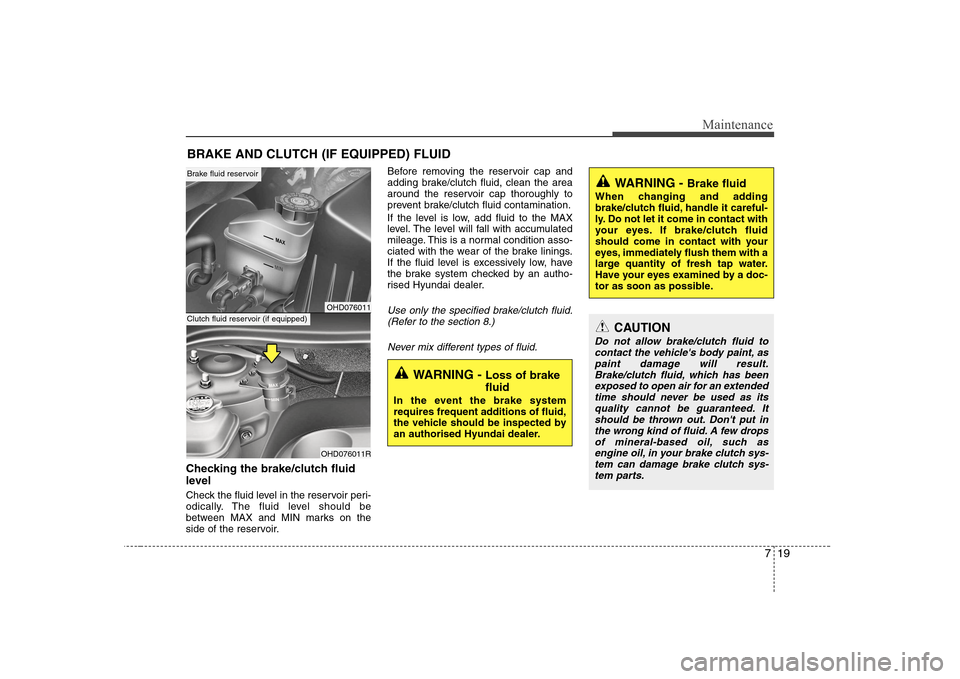
719
Maintenance
BRAKE AND CLUTCH (IF EQUIPPED) FLUID
Checking the brake/clutch fluid
level
Check the fluid level in the reservoir peri-
odically. The fluid level should be
between MAX and MIN marks on the
side of the reservoir. Before removing the reservoir cap and
adding brake/clutch fluid, clean the area
around the reservoir cap thoroughly to
prevent brake/clutch fluid contamination.
If the level is low, add fluid to the MAX
level. The level will fall with accumulated
mileage. This is a normal condition asso-
ciated with the wear of the brake linings.
If the fluid level is excessively low, have
the brake system checked by an autho-
rised Hyundai dealer.
Use only the specified brake/clutch fluid.
(Refer to the section 8.)
Never mix different types of fluid.
WARNING - Brake fluid
When changing and adding
brake/clutch fluid, handle it careful-
ly. Do not let it come in contact with
your eyes. If brake/clutch fluid
should come in contact with your
eyes, immediately flush them with a
large quantity of fresh tap water.
Have your eyes examined by a doc-
tor as soon as possible.
WARNING - Loss of brake fluid
In the event the brake system
requires frequent additions of fluid,
the vehicle should be inspected by
an authorised Hyundai dealer.
CAUTION
Do not allow brake/clutch fluid to contact the vehicle's body paint, as paint damage will result.
Brake/clutch fluid, which has been exposed to open air for an extendedtime should never be used as itsquality cannot be guaranteed. Itshould be thrown out. Don't put in
the wrong kind of fluid. A few dropsof mineral-based oil, such as engine oil, in your brake clutch sys-tem can damage brake clutch sys-
tem parts.
OHD076011
OHD076011R
Brake fluid reservoir
Clutch fluid reservoir (if equipped)
Page 293 of 308
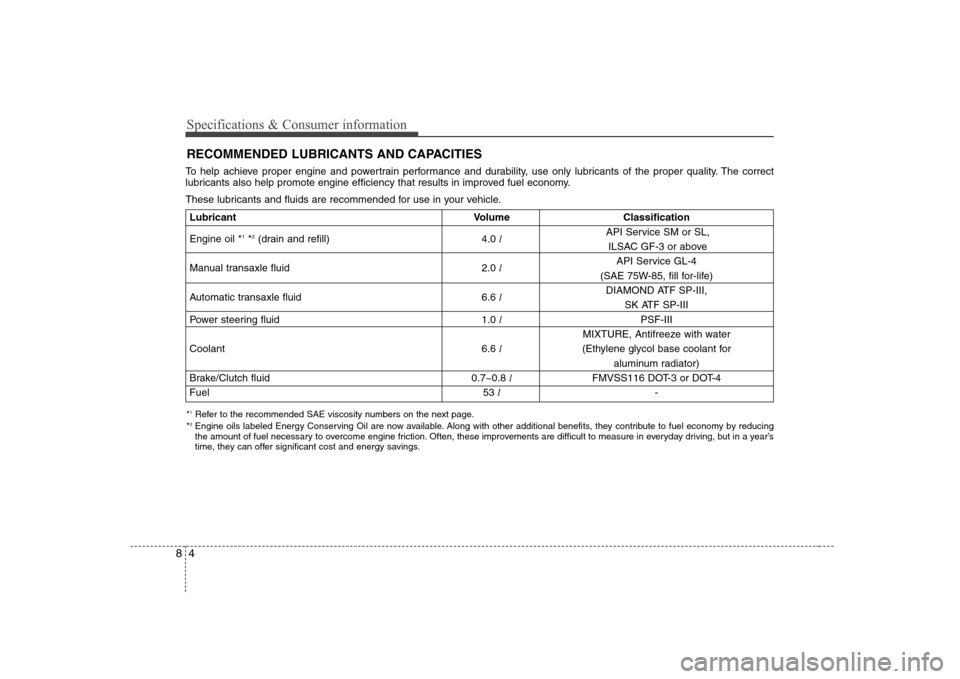
Specifications & Consumer information
4
8
RECOMMENDED LUBRICANTS AND CAPACITIES
To help achieve proper engine and powertrain performance and durability, use only lubricants of the proper quality. The correct
lubricants also help promote engine efficiency that results in improved fuel economy.
These lubricants and fluids are recommended for use in your vehicle.
* 1
Refer to the recommended SAE viscosity numbers on the next page.
* 2
Engine oils labeled Energy Conserving Oil are now available. Along with other additional benefits, they contribute to fuel econo my by reducing
the amount of fuel necessary to overcome engine friction. Often, these improvements are difficult to measure in everyday driving, but in a year’s
time, they can offer significant cost and energy savings.
Lubricant Volume Classification
Engine oil * 1
*2
(drain and refill) 4.0 l
Manual transaxle fluid 2.0 l API Service GL-4
(SAE 75W-85, fill for-life)
Automatic transaxle fluid 6.6 l DIAMOND ATF SP-III,
SK ATF SP-III
Power steering fluid 1.0 l PSF-III
MIXTURE, Antifreeze with water
Coolant 6.6 l (Ethylene glycol base coolant for
aluminum radiator)
Brake/Clutch fluid 0.7~0.8 l FMVSS116 DOT-3 or DOT-4
Fuel 53 l -
API Service SM or SL,
ILSAC GF-3 or above
Page 306 of 308
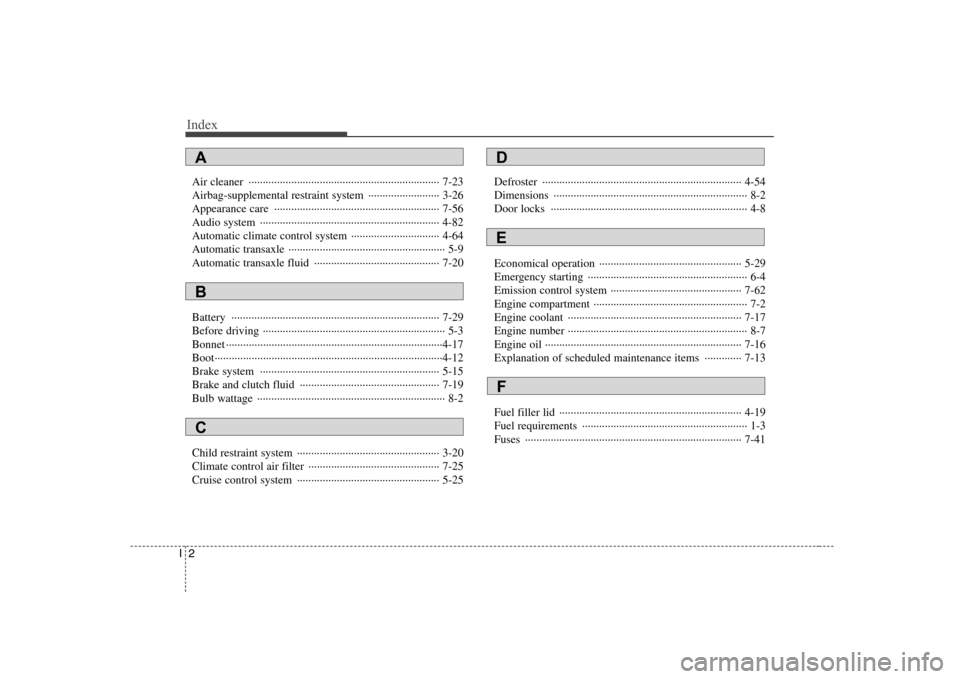
Index
2I
Air cleaner ··································································· 7-23
Airbag-supplemental restraint system ························· 3-26
Appearance care ·························································· 7-56
Audio system ······························································· 4-82
Automatic climate control system ······························· 4-64
Automatic transaxle ······················································· 5-9
Automatic transaxle fluid ············································ 7-20
Battery ········································································· 7-29
Before driving ································································ 5-3
Bonnet ············································································4-17
Boot················································································4-12
Brake system ······························································· 5-15
Brake and clutch fluid ················································· 7-19
Bulb wattage ·································································· 8-2
Child restraint system ·················································· 3-20
Climate control air filter ·············································· 7-25
Cruise control system ·················································· 5-25Defroster ······································································ 4-54
Dimensions ···································································· 8-2
Door locks ····································································· 4-8
Economical operation ·················································· 5-29
Emergency starting ························································ 6-4
Emission control system ·············································· 7-62
Engine compartment ······················································ 7-2
Engine coolant ····························································· 7-17
Engine number ······························································· 8-7
Engine oil ····································································· 7-16
Explanation of scheduled maintenance items ············· 7-13
Fuel filler lid ································································ 4-19
Fuel requirements ·························································· 1-3
Fuses ············································································ 7-41
A
B
C
D
E
F